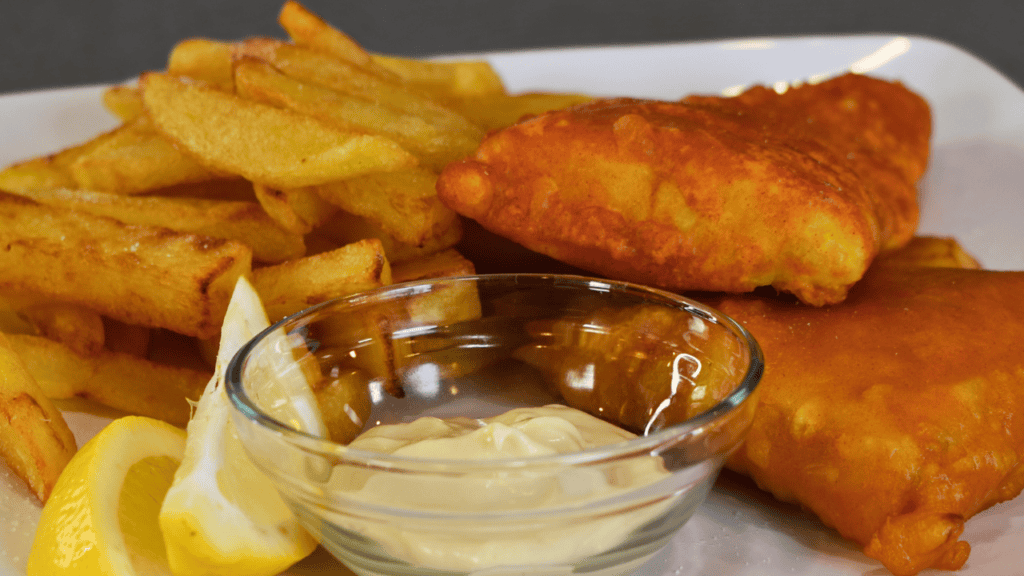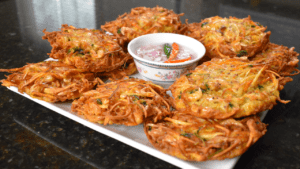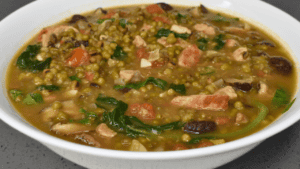Fish and Chips
Fish and chips is a classic British dish that has been enjoyed for centuries. It consists of battered and deep-fried fish, usually cod or haddock, served with crispy fries (chips).

Mastering Fish and Chips at Home The Ultimate Guide for Seafood Lovers
Fish and chips—just the mention of this classic dish can evoke fond memories of seaside trips and comfort food indulgence. Originating from the United Kingdom, this timeless delight has wormed its way into the hearts and kitchens of foodies worldwide. It’s not just a meal; it’s an experience, a taste of tradition with every crispy bite. In this guide, we’ll explore the ins and outs of crafting the perfect fish and chips, from its rich history to the best techniques for achieving that ideal crunch. Whether you’re a seasoned cook or a seafood lover discovering new culinary horizons, this post will provide all you need to revolutionize your fish and chips game.
The Allure of Fish and Chips A Delicious History
Fish and chips have a storied past, deeply rooted in British culture and beyond. Its origins date back to the 19th century, when fried fish met fried potatoes in a serendipitous culinary union. This pairing quickly became a staple in the working-class diet, praised for its affordability and sustenance.
The dish’s popularity exploded during the Industrial Revolution, fueling the hardworking masses. Vendors served it wrapped in newspaper, adding a rustic charm that endures today. Over time, fish and chips transcended borders, becoming an emblem of British cuisine embraced by palates across the globe.
Today, fish and chips are celebrated by food enthusiasts from Sydney to San Francisco. Its appeal lies not only in its satisfying flavors but also in its simplicity. This dish brings people together, offering a taste of tradition that resonates with young and old alike.
Gathering Your Ingredients and Tools for Culinary Success
Creating the perfect fish and chips begins with selecting the right ingredients and tools. Freshness and quality are paramount, ensuring each component shines in the final dish.
Essential Ingredients for Authentic Fish and Chips
- Fish: Opt for firm, white fish such as cod, haddock, or pollock. Their mild flavors and flaky textures are perfect for frying.
- Potatoes: Yukon Gold or Maris Piper potatoes make excellent chips, offering a balance of crispiness and fluffiness.
- Batter: Combine all-purpose flour, cornstarch, baking powder, turmeric, and a cold non-alcoholic beer for a light, crisp coating.
- Oil: Use a neutral oil like vegetable or canola for deep-frying, ensuring a golden finish without overpowering flavors.
- Seasonings: Salt is a must, both for the fish and chips. Consider adding paprika or cayenne for a subtle kick.
Must-Have Tools for a Flawless Finish
- Deep Fryer or Large Pot: Essential for even frying, providing space for the oil and food to circulate freely.
- Tongs: Ideal for handling hot fish and chips with precision.
- Paper Towels: Necessary for absorbing excess oil, keeping the final dish crisp.
- Mixing Bowls: Vital for preparing batter and seasoning the fish.
Step-by-Step Guide to Crafting Perfect Fish and Chips
Follow these steps for a flawless fish and chips experience, from prep to plate.
Preparing the Fish and Chips
- Make the Batter: In a mixing bowl, combine flour, cornstarch, baking powder, and turmeric. Slowly whisk in the cold non-alcoholic beer until smooth. Set aside to rest.
- Prep the Fish: Pat the cod fillets dry with paper towels to remove moisture. Season them generously with salt on both sides.
- Cut the Potatoes: Slice peeled potatoes into uniform shapes. Rinse in cold water to remove excess starch, then dry thoroughly.
Frying the Chips
- First Fry: Heat oil in a deep fryer or large pot to 350°F. Fry the chips in batches for about 10 minutes without browning. Remove them and drain on paper towels. Allow to rest for 10 minutes.
- Second Fry: Reheat the oil to 400°F. Fry the chips again in batches until crispy and golden brown, about 5 minutes. Drain and season with salt.
Frying the Fish
- Coat the Fish: Dredge each cod fillet in flour, then dip into the batter, ensuring even coverage.
- Fry to Perfection: Carefully place the fish into the hot oil, frying until golden brown on both sides, approximately 4-5 minutes.
- Drain and Serve: Place the fried fish on a paper towel-lined plate to absorb excess oil. Serve immediately with crisp chips.
Healthier Alternatives to Classic Fish and Chips
For those seeking a lighter version of fish and chips without compromising flavor, consider these alternatives.
Air Fryer Magic
The air fryer offers a healthier way to enjoy fish and chips by reducing oil usage. Preheat the air fryer, then cook battered fish and chips in separate batches. The result is a crispy exterior with significantly less fat.
Oven-Baked Delight
Baking is another excellent option for a lighter dish. Preheat the oven to 425°F and lay coated fish and chips on a parchment-lined baking sheet. Bake until golden and crispy, turning halfway through for even cooking.
Flavorful Adjustments
Experiment with alternative batters, such as whole wheat flour or gluten-free mixes. Add herbs and spices to the batter for an extra burst of flavor.
Pairing and Serving Ideas to Elevate Your Meal
Fish and chips pair beautifully with various accompaniments, enhancing the dining experience.
Classic Condiments
Serve with traditional condiments like tartar sauce, malt vinegar, or lemon wedges. These additions complement the dish’s savory notes.
Creative Sides
Consider serving with coleslaw, mushy peas, or pickled onions for a refreshing contrast. Each side adds a unique texture and flavor dimension.
Beverage Pairings
Pair with a cold beer, crisp white wine, or a refreshing lemonade. These beverages cut through the richness of the dish, providing balance.
Tips and Tricks for Fish and Chips Perfection
Achieve restaurant-quality results with these pro tips and tricks.
Crispier Batter Techniques
For an ultra-crisp batter, ensure the batter is cold and the oil is hot. Retaining a consistent high temperature prevents sogginess.
Perfectly Cooked Fish
Avoid overcrowding the fryer, as this lowers the oil temperature and affects cooking. Fry in small batches for consistent results.
Preventing Greasy Chips
Ensure chips are thoroughly dry before frying. A second fry at a higher temperature guarantees a crispy, non-greasy finish.
Conclusion Try It Yourself and Share the Joy
Crafting fish and chips at home is a rewarding culinary adventure, offering a taste of tradition and satisfaction. With fresh ingredients, simple tools, and expert techniques, you can recreate this iconic dish with ease.
We invite you to try the recipe and share your experiences with us. Whether you’re a seasoned cook or a newcomer to seafood delights, this guide is your key to success. Explore, experiment, and enjoy the process.
Frequently Asked Questions About Fish and Chips
What is the batter on fish and chips made of?
The batter typically consists of flour, cornstarch, baking powder, turmeric, and a cold liquid, often beer or soda water. This combination ensures a light, crispy coating.
Which fish is used to make fish and chips?
Traditional choices include cod and haddock, known for their mild flavor and flaky texture. Other options include pollock and hake, depending on availability.
What is the best fish for fish and chips?
Cod and haddock are considered the best options due to their texture and flavor. Their ability to hold up well during frying makes them ideal.
How do you get batter to stick to fish?
Pat the fish dry and dredge it in flour before dipping it into the batter. This step helps the batter adhere and prevents it from sliding off during frying.
Do you cook fish or fries first?
Begin by frying the chips for a par-cooked phase. This allows them to rest while you fry the fish, resulting in perfectly cooked components ready simultaneously.
How are fish and chips traditionally made?
Traditionally, fish is battered and deep-fried, while chips are double-fried for a crispy exterior. They are served hot with condiments like vinegar and tartar sauce.
Which fish is best for fish & chips?
For classic fish and chips, cod and haddock remain top choices. Their light, flaky qualities shine when paired with a crisp, golden batter.

Fish and Chips
Ingredients
- 2 lbs cod fillets
- 1½ cups all-purpose flour for batter
- 1 cup all-purpose flour for dredging fish
- 2 tbsp cornstarch
- 2 tsp baking powder
- 1 tsp turmeric
- 1 bottle non-alcoholic beer (12 oz)
- 5 large yukon potatoes
- salt to taste
- oil for frying
Instructions
- In a mixing bowl, combine flour, cornstarch, baking powder, and turmeric. Gradually whisk in the cold non-alcoholic beer until the batter is smooth. Set aside.
- Pat the cod fillets dry with paper towels to remove moisture, preventing soggy batter. Generously season both sides with salt.
- Cut peeled potatoes into your preferred shapes. Rinse them in a large bowl of water, drain, and pat dry with paper towels.
- Heat enough vegetable oil in a large pot or deep fryer over medium-high heat. Fry the chips in batches for about 10 minutes without browning. Remove and drain on paper towels. Rest for 10 minutes.
- Reheat the oil to 400°F and fry the chips again in batches until crispy and golden brown, about 5 minutes. Drain and season with salt.
- Coat each cod fillet with flour, then dip into the prepared batter, ensuring even coverage. Use tongs to carefully place them into the hot oil.
- Fry until golden brown on both sides, about 4-5 minutes depending on the thickness of the fillets.
- Once cooked and crispy, remove the fish from the oil and place on a paper towel-lined plate to absorb excess oil.
- Serve the fish with the crispy fries for a classic British meal. Add tartar sauce or malt vinegar on the side for extra flavor.





















